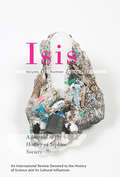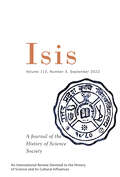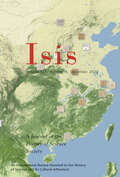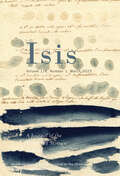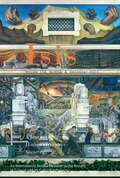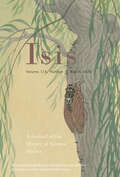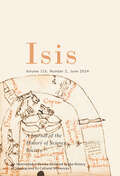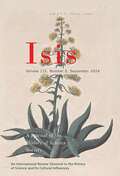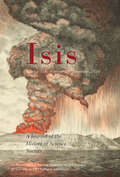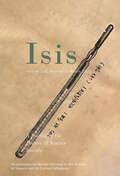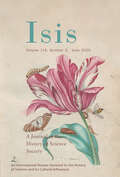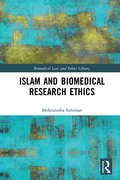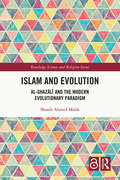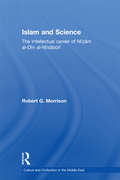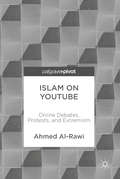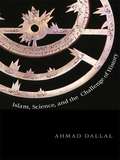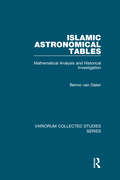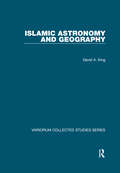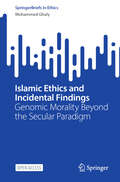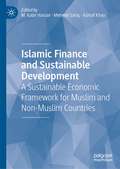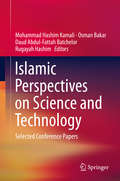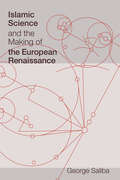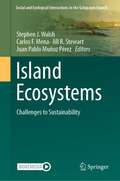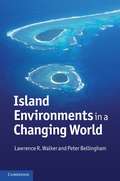- Table View
- List View
Isis, volume 113 number 2 (June 2022)
by IsisThis is volume 113 issue 2 of Isis. Since its inception in 1912, Isis has featured scholarly articles, research notes, and commentary on the history of science, medicine, and technology and their cultural influences. Review essays and book reviews on new contributions to the discipline are also included. An official publication of the History of Science Society, Isis is the oldest English-language journal in the field.
Isis, volume 113 number 3 (September 2022)
by IsisThis is volume 113 issue 3 of Isis. Since its inception in 1912, Isis has featured scholarly articles, research notes, and commentary on the history of science, medicine, and technology and their cultural influences. Review essays and book reviews on new contributions to the discipline are also included. An official publication of the History of Science Society, Isis is the oldest English-language journal in the field.
Isis, volume 113 number 4 (December 2022)
by IsisThis is volume 113 issue 4 of Isis. Since its inception in 1912, Isis has featured scholarly articles, research notes, and commentary on the history of science, medicine, and technology and their cultural influences. Review essays and book reviews on new contributions to the discipline are also included. An official publication of the History of Science Society, Isis is the oldest English-language journal in the field.
Isis, volume 114 number 1 (March 2023)
by IsisThis is volume 114 issue 1 of Isis. Since its inception in 1912, Isis has featured scholarly articles, research notes, and commentary on the history of science, medicine, and technology and their cultural influences. Review essays and book reviews on new contributions to the discipline are also included. An official publication of the History of Science Society, Isis is the oldest English-language journal in the field.
Isis, volume 114 number 3 (September 2023)
by IsisThis is volume 114 issue 3 of Isis. Since its inception in 1912, Isis has featured scholarly articles, research notes, and commentary on the history of science, medicine, and technology and their cultural influences. Review essays and book reviews on new contributions to the discipline are also included. An official publication of the History of Science Society, Isis is the oldest English-language journal in the field.
Isis, volume 114 number 4 (December 2023)
by IsisThis is volume 114 issue 4 of Isis. Since its inception in 1912, Isis has featured scholarly articles, research notes, and commentary on the history of science, medicine, and technology and their cultural influences. Review essays and book reviews on new contributions to the discipline are also included. An official publication of the History of Science Society, Isis is the oldest English-language journal in the field.
Isis, volume 115 number 1 (March 2024)
by IsisThis is volume 115 issue 1 of Isis. Since its inception in 1912, Isis has featured scholarly articles, research notes, and commentary on the history of science, medicine, and technology and their cultural influences. Review essays and book reviews on new contributions to the discipline are also included. An official publication of the History of Science Society, Isis is the oldest English-language journal in the field.
Isis, volume 115 number 2 (June 2024)
by IsisThis is volume 115 issue 2 of Isis. Since its inception in 1912, Isis has featured scholarly articles, research notes, and commentary on the history of science, medicine, and technology and their cultural influences. Review essays and book reviews on new contributions to the discipline are also included. An official publication of the History of Science Society, Isis is the oldest English-language journal in the field.
Isis, volume 115 number 3 (September 2024)
by IsisThis is volume 115 issue 3 of Isis. Since its inception in 1912, Isis has featured scholarly articles, research notes, and commentary on the history of science, medicine, and technology and their cultural influences. Review essays and book reviews on new contributions to the discipline are also included. An official publication of the History of Science Society, Isis is the oldest English-language journal in the field.
Isis, volume 115 number 4 (December 2024)
by IsisThis is volume 115 issue 4 of Isis. Since its inception in 1912, Isis has featured scholarly articles, research notes, and commentary on the history of science, medicine, and technology and their cultural influences. Review essays and book reviews on new contributions to the discipline are also included. An official publication of the History of Science Society, Isis is the oldest English-language journal in the field.
Isis, volume 116 number 1 (March 2025)
by IsisThis is volume 116 issue 1 of Isis. Since its inception in 1912, Isis has featured scholarly articles, research notes, and commentary on the history of science, medicine, and technology and their cultural influences. Review essays and book reviews on new contributions to the discipline are also included. An official publication of the History of Science Society, Isis is the oldest English-language journal in the field.
Isis, volume 116 number 2 (June 2025)
by IsisThis is volume 116 issue 2 of Isis. Since its inception in 1912, Isis has featured scholarly articles, research notes, and commentary on the history of science, medicine, and technology and their cultural influences. Review essays and book reviews on new contributions to the discipline are also included. An official publication of the History of Science Society, Isis is the oldest English-language journal in the field.
Islam and Biomedical Research Ethics (Biomedical Law and Ethics Library)
by Mehrunisha SulemanThis book is a contribution to the nascent discourse on global health and biomedical research ethics involving Muslim populations and Islamic contexts. It presents a rich sociological account about the ways in which debates and questions involving Islam within the biomedical research context are negotiated - a perspective which is currently lacking within the broader bioethics literature. The book tackles some key understudied areas including: role of faith in moral deliberations within biomedical research ethics, the moral anxiety and frustration experienced by researchers when having to negotiate multiple moral sources and how the marginalisation of women, the prejudice and abuse faced by groups such as sex workers and those from the LGBT community are encountered and negotiated in such contexts. The volume provides a valuable resource for researchers and scholars in this area by providing a systematic review of ethical guidelines and a rich case-based account of the ethical issues emerging in biomedical research in contexts where Islam and the religious moral commitments of Muslims are pertinent. The book will be essential for those conducting research in low and middle income countries that have significant Muslim populations and for those in Muslim-minority settings. It will also appeal to researchers and scholars in religious studies, social sciences, philosophy, anthropology and theology, as well as the fields of biomedical ethics, Islamic ethics and global health..
Islam and Evolution: Al-Ghazālī and the Modern Evolutionary Paradigm (Routledge Science and Religion Series)
by Shoaib Ahmed MalikThis book attempts to equip the reader with a holistic and accessible account of Islam and evolution. It guides the reader through the different variables that have played a part in the ongoing dialogue between Muslim creationists and evolutionists. This work views the discussion through the lens of al-Ghazālī (1058-1111), a widely-known and well-respected Islamic intellectual from the medieval period. By understanding al-Ghazālī as an Ash’arite theologian, a particular strand of Sunni theology, his metaphysical and hermeneutic ideas are taken to explore if and how much Neo-Darwinian evolution can be accepted. It is shown that his ideas can be used to reach an alignment between Islam and Neo-Darwinian evolution. This book offers a detailed examination that seeks to offer clarity if not agreement in the midst of an intense intellectual conflict and polarity amongst Muslims. As such, it will be of great interest to scholars of Science and Religion, Theology, Philosophy of Religion, Islamic Studies, and Religious Studies more generally.
Islam and Science: The Intellectual Career of Nizam al-Din al-Nisaburi (Culture and Civilization in the Middle East)
by Robert MorrisonIn examining the work of eminent fourteenth century Iranian Shiite scholar Nizam al-Din al-Nisaburi, this book is the first rigorous attempt to explain the cross-fertilization of scientific and religious thought in Islamic civilization. Nisaburi did not consider himself a scientist alone, being commissioned by his patrons to work in a variety of fields. Islam and Science examines in detail the relationship between the metaphysics of Nisaburi's science, and statements he made in his Qur'an commentary and in other non-scientific writings. Sources suggest that Nisaburi was inspired to begin his scientific career by the inclusion of basic science in a religious (madrasa) education. By mid-career, he had found methodological similarities between theoretical astronomy and Islamic jurisprudence. Morrison concludes that while Nisaburi believed science could give one a taste of God's knowledge, he realised that the study of science and natural philosophy alone could not lead him to a spiritual union with God. Only Sufi practice and Sufi theory could accomplish that. Morrison's work is remarkable in synthesizing the history of Islamic science with other areas of Islamic studies. It will be of interest to students and scholars of religion and the history of science, as well as readers with a more general interest in Middle Eastern studies. Winner of the Iranian World Prize for Book of the Year in Islamics Studies 2009
Islam on YouTube
by Ahmed Al-RawiThis book offers empirical insight into the way Muslims reacted online towards various controversial issues related to Islam. The book examines four cases studies: The Muhammed's cartoons, the burning of the Quran controversies, Fitna and the Innocence of Muslims' films. The issues of online religion, social movements and extremism are discussed, as many of the cases in question created both uproar and unity among many YouTubers. These case studies - in some instances - led to the expression of extremist views by some users, and the volume argues that they helped contribute to the growth of extremism due to the utilization of these events by some terrorist groups in order to recruit new members. In the concluding chapter, social network and sentiment analyses are presented in order to investigate all the collected comments and videos, while a critical discussion of freedom of expression and hate speech is offered, with special regards to the growing online influ ence of far right groups and their role in on-going YouTube debates.
Islam, Science, and the Challenge of History
by Ahmad DallalIn this wide-ranging and masterful work, Ahmad Dallal examines the significance of scientific knowledge and situates the culture of science in relation to other cultural forces in Muslim societies. He traces the ways in which the realms of scientific knowledge and religious authority were delineated historically. The realization of a discrepancy between tradition and science often led to demolition and rebuilding and, most important, to questioning whether scientific knowledge should take precedence over religious authority in a matter where their realms clearly overlap. Dallal frames his inquiry around three concerns: What cultural forces provided the conditions for debate over the primacy of religion or science? How did these debates emerge? And how were they sustained? His primary objectives are to study science in Muslim societies within its larger cultural context and to trace the epistemological distinctions between science and philosophy, on the one hand, and science and religion, on the other. He looks at religious and scientific texts and situates them in the contexts of religion, philosophy, and science. Finally, Dallal describes the relationship negotiated in the classical (medieval) period between the religious, scientific, and philosophical systems of knowledge that is central to the Islamic scientific tradition and shows how this relationship has changed radically in modern times.
Islamic Astronomical Tables: Mathematical Analysis and Historical Investigation (Variorum Collected Studies #1040)
by Benno van DalenThis volume comprises nine articles on Islamic astronomy published since 1989 by Benno van Dalen. Van Dalen was the first historian of Islamic astronomy who made full use of the new possibilities of computers in the early 1990s. He implemented various statistical and numerical methods that can be used to determine the mathematical properties of medieval astronomical tables, and utilized these to obtain entirely new, until then unattainable historical results concerning the interdependence of individual tables and hence of entire astronomical works. His programmes for analysing tables, making sexagesimal calculations and converting calendar dates continue to be widely used. The five articles in the first part of this collection explain the principles of a range of statistical methods for determining unknown parameter values underlying astronomical tables and present extensive step-by-step examples for their use. The four articles in the second part provide extensive studies of materials in unpublished primary sources on Islamic astronomy that heavily depend on these methods. The volume is completed with a detailed index.
Islamic Astronomy and Geography
by David A. KingThis volume of 12 studies, mainly published during the past 15 years, begins with an overview of the Islamic astronomy covering not only sophisticated mathematical astronomy and instrumentation but also simple folk astronomy, and the ways in which astronomy was used in the service of religion. It continues with discussions of the importance of Islamic instruments and scientific manuscript illustrations. Three studies deal with the regional schools that developed in Islamic astronomy, in this case, Egypt and the Maghrib. Another focuses on a curious astrological table for calculating the length of life of any individual. The notion of the world centred on the sacred Kaaba in Mecca inspired both astronomers and proponents of folk astronomy to propose methods for finding the qibla, or sacred direction towards the Kaaba; their activities are surveyed here. The interaction between the mathematical and folk traditions in astronomy is then illustrated by an 11th-century text on the qibla in Transoxania. The last three studies deal with an account of the geodetic measurements sponsored by the Caliph al-Ma'mûn in the 9th century; a world-map in the tradition of the 11th-century polymath al-Bîrûnî, alas corrupted by careless copying; and a table of geographical coordinates from 15th-century Egypt.
Islamic Ethics and Incidental Findings: Genomic Morality Beyond the Secular Paradigm (SpringerBriefs in Ethics)
by Mohammed GhalyThis open access book offers unique insights into the key ethical issues faced by practitioners and discussed by ethicists in the field of genomics and incidental findings, with a focus on the Islamic moral tradition. Embark on an enlightening exploration of key ethical challenges in genomics and incidental findings, uniquely tailored to the context of the Muslim Arab world. Following the regional scientific leap in genomic infrastructure, this study provides a timely response to the need for a solid evidence base that pairs scientific research with cutting-edge research in Islamic ethics. A variety of expert perspectives have been incorporated, which produce a holistic overview of the intricate, interwoven systems, including the status quo of genomic research in the Gulf region, related Islamic ethical deliberations, and, finally, the governing jurisdictions and regulations on the ground. This publication stands as a pioneer work for academics interested in various fields, including genomics, bioethics, and Islamic studies. It equally serves as an invaluable guide for practitioners and policy-makers, equipping them to make informed decisions that resonate with the socio-cultural and religio-ethical nuances of the Islamic tradition. Being multidisciplinary in nature, the study is written in such a way that makes it accessible for those without a specialized background in Islamic studies or genomics.
Islamic Finance and Sustainable Development: A Sustainable Economic Framework for Muslim and Non-Muslim Countries
by Ashraf Khan M. Kabir Hassan Mehmet SaraçThe book is a collection of chapters discussing the Sustainable Development Goals in the broader context of Islamic finance along with mapping the SDGs with Maqasid Al-Shariah. It provides a framework for both Muslim and non-Muslim countries to develop a sustainable economy which encompasses not only the concept of the welfare state but also supports development-related activities, ensures financial inclusion through equal distribution of wealth and alleviation of poverty, and protects the overall environmental and ecological system. More specifically, this book explores various aspects of Islamic finance in relation to parameters of SDGs; restructuring of Islamic finance and connecting its dots in the light of SDGs; Islamic perspective on ESG and ecological quality; interest-free tools and modernization of Islamic financial institutions for sustainable development and economic stability; and the role of Islamic finance in infrastructure-related development activities. Consistent with the view that SDGs are embedded within the theme of Islamic finance, this book is specifically designed to meet the needs of key regulatory institutions, academic scholars, and industry practitioners both in the field of Islamic finance and sustainable finance.
Islamic Perspectives on Science and Technology
by Mohammad Hashim Kamali Osman Bakar Daud Abdul-Fattah Batchelor Rugayah HashimThis book presents 25 selected papers from the International Conference on "Developing Synergies between Islam & Science and Technology for Mankind's Benefit" held at the International Institute for Advanced Islamic Studies Malaysia, Kuala Lumpur, in October 2014. The papers cover a broad range of issues reflecting the main conference themes: Cosmology and the Universe, Philosophy of Science and the Emergence of Biological Systems, Principles and Applications of Tawhidic Science, Medical Applications of Tawhidic Science and Bioethics, and the History and Teaching of Science from an Islamic Perspective. Highlighting the relationships between the Islamic religious worldview and the physical sciences, the book challenges secularist paradigms on the study of Science and Technology. Integrating metaphysical perspectives of Science, topics include Islamic approaches to S&T such as an Islamic epistemology of the philosophy of science, a new quantum theory, environmental care, avoiding wasteful consumption using Islamic teachings, and emotional-blasting psychological therapy. Eminent contributing scholars include Osman Bakar, Mohammad Hashim Kamali, Mehdi Golshani, Mohd. Kamal Hassan, Adi Setia and Malik Badri. The book is essential reading for a broad group of academics and practitioners, from Islamic scholars and social scientists to (physical) scientists and engineers.
Islamic Science and the Making of the European Renaissance (Transformations: Studies in the History of Science and Technology)
by George SalibaThe rise and fall of the Islamic scientific tradition, and the relationship of Islamic science to European science during the Renaissance. The Islamic scientific tradition has been described many times in accounts of Islamic civilization and general histories of science, with most authors tracing its beginnings to the appropriation of ideas from other ancient civilizations—the Greeks in particular. In this thought-provoking and original book, George Saliba argues that, contrary to the generally accepted view, the foundations of Islamic scientific thought were laid well before Greek sources were formally translated into Arabic in the ninth century. Drawing on an account by the tenth-century intellectual historian Ibn al-Naidm that is ignored by most modern scholars, Saliba suggests that early translations from mainly Persian and Greek sources outlining elementary scientific ideas for the use of government departments were the impetus for the development of the Islamic scientific tradition. He argues further that there was an organic relationship between the Islamic scientific thought that developed in the later centuries and the science that came into being in Europe during the Renaissance.Saliba outlines the conventional accounts of Islamic science, then discusses their shortcomings and proposes an alternate narrative. Using astronomy as a template for tracing the progress of science in Islamic civilization, Saliba demonstrates the originality of Islamic scientific thought. He details the innovations (including new mathematical tools) made by the Islamic astronomers from the thirteenth to sixteenth centuries, and offers evidence that Copernicus could have known of and drawn on their work. Rather than viewing the rise and fall of Islamic science from the often-narrated perspectives of politics and religion, Saliba focuses on the scientific production itself and the complex social, economic, and intellectual conditions that made it possible.
Island Ecosystems: Challenges to Sustainability (Social and Ecological Interactions in the Galapagos Islands)
by Stephen J. Walsh Carlos F. Mena Jill R. Stewart Juan Pablo Muñoz PérezSustainable development is a process to improve the quality of life of people, while maintaining the ability of social–ecological systems to continue to provide valuable ecological services that social systems require. In the Galapagos Islands, the maintenance of amenity resources to support tourism and the quality of life of residents is explicitly linked to ecosystem goods and services, particularly, the accessibility to high-quality natural environments and the terrestrial and marine visitation sites that showcase iconic species.On June 26-30, 2022, the Galapagos Science Center celebrated its 10-Year Anniversary. As the crowning event of the anniversary celebration, the World Summit on Island Sustainability was held on San Cristobal Island, Galapagos Archipelago of Ecuador. The intent of the World Summit was to bring together leading experts on island ecosystems and, particularly, on island sustainability from across the globe to represent a diversity of perspectives, approaches, and stakeholder groups. The World Summit was an exclusive event that featured an “expert convening” of scholars and practitioners to address the social, terrestrial, and marine sub-systems of the Galapagos Islands and other similarly challenged island ecosystems from around the globe. The World Summit attracted 150 scientists to the Galapagos Islands to discuss projects conducted, for instance, in the Galapagos Islands, Hawaii, Guam, French Polynesia, Chile, Australia, and the Caribbean Islands. Island vulnerability, resilience, and sustainability were examined by scholars, for instance, from the University of North Carolina at Chapel Hill, Universidad San Francisco de Quito, Catholic University of Chile, University of Guam, James Cook University, University of the Sunshine Coast, North Carolina State University, North Carolina Museum of Natural Sciences, California Academy of Sciences, University of San Francisco, and the University of South Alabama as well as affiliated scientists from Exeter University, University of Edinburgh, University of Southampton, and the Galapagos National Park. The World Summit also included scholars from Re:wild, World Wildlife Fund, EarthEcho, and the East-West Center, Hawaii.
Island Environments in a Changing World
by Lawrence R. Walker Peter BellinghamIslands represent unique opportunities to examine human interaction with the natural environment. They capture the human imagination as remote, vulnerable and exotic, yet there is comparatively little understanding of their basic geology, geography, or the impact of island colonization by plants, animals and humans. This detailed study of island environments focuses on nine island groups, including Hawaii, New Zealand and the British Isles, exploring their differing geology, geography, climate and soils, as well as the varying effects of human actions. It illustrates the natural and anthropogenic disturbances common to island groups, all of which face an uncertain future clouded by extinctions of endemic flora and fauna, growing populations of invasive species, and burgeoning resident and tourist populations. Examining the natural and human history of each island group from early settlement onwards, the book provides a critique of the concept of sustainable growth and offers realistic guidelines for future island management.
